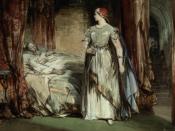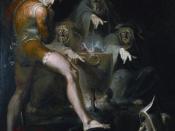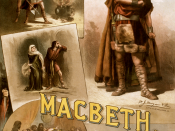The Many Meanings of Blood
Blood is known to everyone to represent life, death, and often injury. Blood is an essential part of life and without blood we could not live. Because of Shakespeare's use of the symbol of blood to represent treason, murder and death in his play Macbeth, it is easily understood and fits in perfectly with the ideas we have of blood. Blood is a dramatic symbol in the play Macbeth.
At the beginning of the play, after Macbeth and the Scottish army defeated the rebel Macdonwald's army, a bleeding sergeant comes on stage. The sergeant then proceeds to describe the battle and how bravely Macbeth and his friend Banquo fought, "For brave Macbeth-well he deserves that name- / Disdaining fortune, with his brandish'd steel / Which smok'd with bloody execution, / Like valor's minion carv'd out his passage..." (Act I, Scene 2, Lines 19-21).
Blood is symbolic of bravery and courage in this passage. In Shakespeare's time and in this play, blood shed for a noble cause is accepted and considered honorable. However, Macbeth's character changes throughout the play are characterized by the symbolism in the blood he sheds.
Before Duncan's murder, Macbeth imagines seeing a dagger floating in the air before him. He describes it, "And on thy blade and dudgeon gouts of blood, / Which was not so before. There's no such thing: / It is the bloody business which informs / Thus to mine eyes." The blood imagery in this passage obviously refers to treason, ambition, and murder. This is a stark contrast to what blood meant earlier in the play. Blood, once seen as a positive value, is now associated with evil. This imagery also shows the beginning of Macbeth's character transformation from a personage of nobility,


